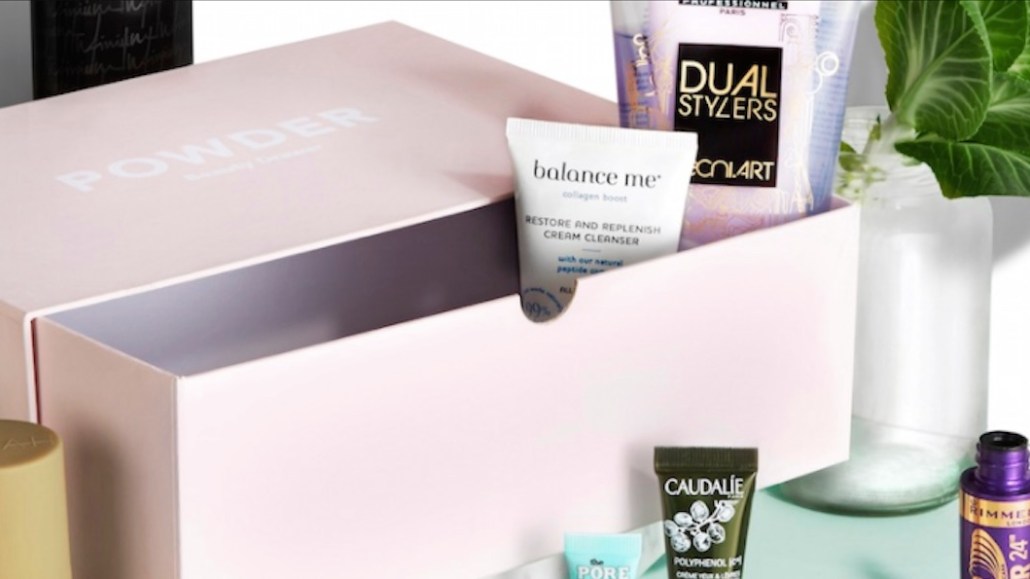Save 50% on a 3-month Digiday+ membership. Ends Dec 12.

Since its launch in February 2016, Time Inc. UK’s beauty content and e-commerce site Powder has amassed 250,000 registered users, according to the publisher.
The site serves up relevant content to users who have provided information on their beauty needs, like articles on how to find the perfect red lipstick for your skin tone, as well as surveys to find your ideal product. Powder’s revenue is 80 percent branded content, with the rest coming from affiliate links, which appear in articles and product recommendations. In the past year, Powder’s revenue has grown by 200 percent, but the publisher couldn’t share exact figures.
While some publishers have delved into e-commerce by building tech platforms that automatically pull in application programming interface feeds to match with webpage tags, Powder’s key is in the editorial direction from its beauty editors. The team, led by publisher and editorial director Bethany Ostacchini, has grown from three to eight since launch.
“In personalization, the key is in the person; there is always someone behind making the decisions,” said Ostacchini. “A mascara could be tagged as waterproof, but that doesn’t tell you whether it’s the best product in the market.”
Powder has some 4,000 products in its catalog, which are organized into 30 categories across makeup, skin care and hair products. A popular category, like moisturizer, drives roughly tens of thousands of pounds in monthly revenue for Time Inc.
Across retailers, Powder drives e-commerce sales in the high six figures each month, but this varies depending on promotional offers and the season, said Ostacchini. It works with between 50 and 100 different retailers, including John Lewis, Boots and Estée Lauder, choosing those that have mobile-optimized sites — Ostacchini said 70 percent of Powder’s traffic comes from mobile — and ones that buyers likely recognize. It takes a cut of between 2 and 20 percent of each purchase. Products range from £5 ($6.45) to £300 ($387).
Each month, Powder sends between 20,000 and 40,000 clicks to retailers, according to the company. Because the product recommendations are targeted to specific audiences, the conversion rate is high. (While it varies by sector, industry averages for conversion rate hover between 1 and 2 percent.) Traffic to specialist retailers fetches a conversion rate of 20 percent, while for more general retailers it drops to about 7 percent. Since launch, Powder has calculated that, on average, those who purchase have spent £108 ($139) on two products.
Powder’s tech platform requires some manual heavy lifting compared to more automated e-commerce platforms that pull in APIs based on factors like price or location. Each category has its own algorithm configuration, and it plans to double the number of categories to 60 by year’s end. Introducing a new category, like dry shampoo or face masks, could take between three and five days. The team has to create a library of products, test them, design the questions to ask readers (which could take different forms like multiple choice, yes or no or a sliding scale), then score each product against each question. A product like foundation could be scored against 50 variables, whereas an item like toothpaste would have just a handful.
Six weeks ago, Powder delved further into e-commerce by launching subscription boxes, an initiative Ostacchini said was always on Powder’s road map, but the site’s first-year focus was building the brand among audiences and advertisers. There are two box options: a monthly beauty box with eight sample-size products chosen by the Powder team and a one-time personalized, seasonal beauty box with 13 sample-size products tailored to the individual by pulling in their preferences. A third-party company manages the fulfillment of the boxes. “We’re clear on the products we need [to fill these boxes] because we have rich customer data,” Ostacchini said. For spring, Powder sold out of its 10,000 personalized beauty boxes in three weeks.
Moving forward, Ostacchini said the site will focus on driving up affiliate revenue streams, which have a relatively high margin, and introducing more product updates, like peer-to-peer reviews or price-comparison features.
More in Media

WTF is AI citation tracking?
Publishers are tracking AI citations to understand visibility, attribution gaps and referral traffic in these tools and platforms.

As big brands flood the podcast ad space, startups are refining strategies to stand out
While a influx of big advertisers is good news for podcast companies, it also makes it more challenging for small- to mid-sized brands to stand out in the space.

Meta enters AI licensing fray, striking deals with People Inc., USA Today Co. and more
The platform has secured seven multi-year deals with publishers including CNN, Fox News, People Inc., USA Today Co to incorporate their content into its large language model (LLM) Llama.








